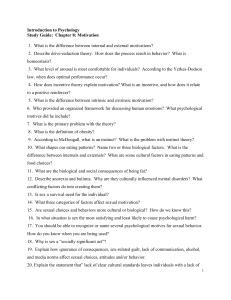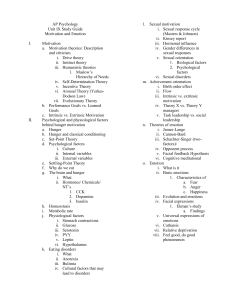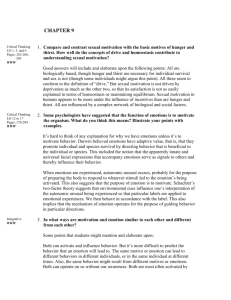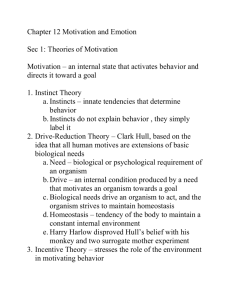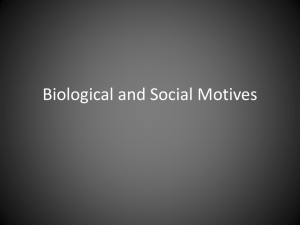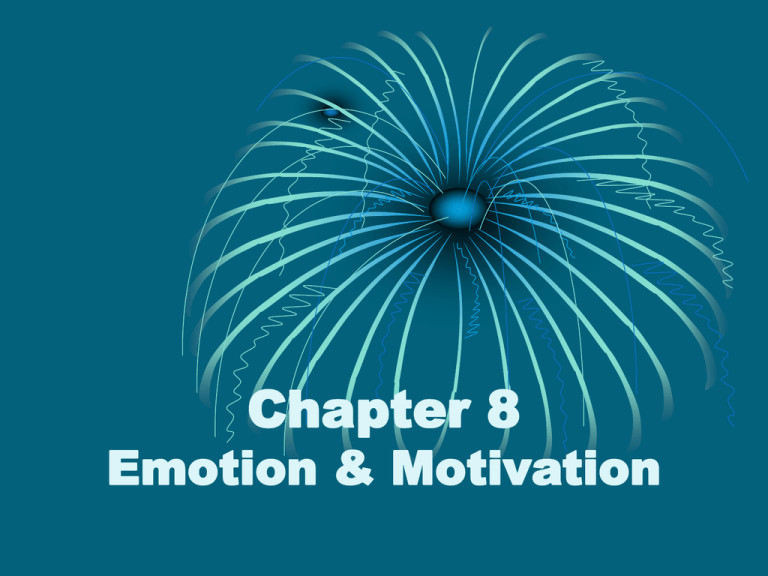
Chapter 8
Emotion & Motivation
Emotions:
Positive or Negative Feeling States
• Emotion: a positive or negative feeling state
typically including some combination of
physiological arousal, cognitive appraisal, and
behavioral expression
What is an emotion?
• Emotions are responses, including
physiological responses
• Sense or experience of feeling
• Leads to expression, behavior;
can be a motive
• Related to thoughts and beliefs as
well as immediate experience
Emotions
• Basic emotions are universal
• They include happiness, fear,
anger, surprise, sadness,
disgust, interest, etc.
• Facial expressions (also
universal) are the most reliable
cues
Functionalist View of Emotion
• What is their purpose?
• Emotions are means of communicating
and play a role in relationships.
• They are also linked to an individual’s
goals and motivation toward progress
and overcoming obstacles.
• Subjective evaluation of good and bad;
comparable to pain in the physical
realm
What is emotional intelligence (EQ)?
• Gardners “interpersonal intelligence”
• Salovey & Mayer (1990): ability to
perceive and express emotion accurately
• MSCEIT (2002) Mayer-Salovey-Caruso
Emotional Intelligence Test
• Daniel Goleman (1995) Published a book,
“Emotional Intelligence”
What is emotional intelligence
(EQ)?
Salovey & Mayer (1990): ability to
perceive and express emotion
accurately, including:
taking perspective
understanding the roles of emotion in
relationships
using feelings to facilitate thought
managing emotions such as anger
Emotions Gone Awry
• . . . Are the basis for some
mental disorders.
•
•
•
•
•
Clinical depression
Bipolar disorder
Anxiety disorders
Intermittent explosive disorder
Antisocial personality disorder
Emotions: Unifying Characteristics
• Involve reactions of many bodily systems,
• Expressions are based on genetically transmitted
mechanisms but are altered by learning and
interpretation of events,
• Communicate information between people, and are
important to relationships.
• Help individuals respond to changes in their
environment.
Emotions Result in Bodily Responses
• The autonomic nervous system
produces bodily responses of
emotion.
• It has two separate branches:
• Sympathetic: geared toward energy
expenditure
• Parasympathetic: geared toward
energy conservation and “refueling”
Three Brain Regions Coordinate
Emotional Responses
• The hypothalamus
• vital link between higher-order cognition (forebrain)
and the lower brain (homeostatic control of the body)
• The limbic system (amygdala)
• Two distinct neural circuits produce emotional
responses, particularly fear
• The cerebral cortex
• Important for the subjective experience of emotions
Cognition and Emotion
• The brain’s shortcut for emotions
Emotional Arousal
Lie Detectors
• Polygraph
• machine commonly used in attempts
to detect lies
• measures several arousal responses
that accompany emotion
• perspiration
• heart rate
• blood pressure
• breathing changes
Emotion - Lie Detectors
Respiration
Perspiration
Heart rate
Control Relevant
question question
(a)
Control
question
Relevant
question
(b)
Emotion - Lie Detectors
• 50 Innocents
• 50 Thieves
Percentage
80
70
60
50
40
30
20
10
0
Innocent
people
Guilty
people
Judged innocent by polygraph
Judged guilty by polygraph
• 1/3 of innocent
declared guilty
• 1/4 of guilty
declared
innocent (from
Kleinmuntz &
Szucko, 1984)
Subjective Well-Being
• self-perceived happiness or
satisfaction with life/contentment
• used along with measures of
objective well-being
• physical and economic indicators to
evaluate people’s quality of life
Emotional Well-being
• Does money buy happiness?
Average
per-person
after-tax income
in 1995 dollars
$20,000
$19,000
$18,000
100%
$17,000
90%
$16,000
$15,000
80%
$14,000
70%
$13,000
Personal income
$12,000
60%
$11,000
50%
$10,000
Percentage very happy 40%
$9,000
30%
$8,000
$7,000
20%
$6,000
10%
$5,000
0%
$4,000
1930 1940 1950 1960 1970 1980 1990 2000
Year
Percentage
describing
themselves as
very happy
Emotional Well-being
• Values and life satisfaction
0.6
Importance
scores
0.4
Money
Love
0.2
0.0
-0.2
-0.4
1.00
2.00
3.00
4.00
5.00
Life satisfaction
6.00
7.00
Emotional Well-being
• Adaptation-Level Phenomenon
• tendency to form judgments relative to a
“neutral” level
• brightness of lights
• volume of sound
• level of income
• defined by our prior experience
• Relative Deprivation
• perception that one is worse off relative to
those with whom one compares oneself
Factors Affecting Happiness
Researchers Have Found That
Happy People Tend to
However, Happiness Seems Not Much
Related to Other Factors, Such as
Have high self-esteem
(in individualistic countries)
Age
Be optimistic, outgoing, and agreeable
Gender (women are more often
depressed, but also more often joyful)
Have close friendships or a satisfying
marriage
Education levels
Have work and leisure that engage
their skills
Parenthood (having children or not)
Have a meaningful religious faith
Physical attractiveness
Sleep well and exercise
Emotions are Motivating
• Feel bad-Do Bad: the negative emotions
of anger and fear usually result in
maladaptive responses
Emotions are Motivating
• Feel-good, do-good
phenomenon
• people’s tendency to be helpful
when already in a good mood
Motivation Is a Dynamic
Process
• The study of motivation is
essentially the study of what
moves a person or animal to act
in a particular way.
• Motivation: an inner state that
energizes behavior toward the
fulfillment of a goal
Theories of Motivation
Internal: something about the
organism pushes it toward (or
away from) some object
External: attributes of the goal
or the environment pull the
organism in a certain direction
Biological Motivation:
Drive Reduction Theories:
• Homeostasis: tendency to keep
physiological systems internally balanced
and adjusting in response to change
• an imbalance in homeostasis creates a
physiological need, which produces a drive that
motivates the organism to satisfy the need
Drive-Reduction Theory
Arousal Motivation
Maintaining an Optimal Level
• Research indicates too low levels
of arousal are as uncomfortable as
those that are too high.
• Yerkes-Dodson law.
• Best performance occurs when we are at
an intermediate level of arousal.
The Yerkes-Dodson Law
Incentive Motivation:
External Factors Motivate Behavior
• Behavior is directed toward attaining
desirable stimuli (positive incentives) &
avoiding undesirable stimuli ( negative
incentives). (Remember operant
conditioning: an incentive is the promise
of reinforcement.)
• Any stimulus that we learn to associate
with positive or negative outcomes can
serve as an incentive for behavior.
Incentive Theory: External
Factors Motivate Behavior
• Researchers distinguish two types of
motivation:
• Intrinsic motivation: a behavior or an
activity that a person perceives as a valued
goal in its own right
• Extrinsic motivation: type of motivation
that leads a person to engage in a behavior
or an activity for external reasons
Maslow Proposed Some Needs Must
Be Met before Others
• We are born with a hierarchy of needs.
• First, basic safety and survival needs needs must be
sufficiently satisfied.
• Next, the person is motivated by more social needs
such as the desire for intimacy, love, and acceptance
from others.
• These are followed by esteem needs such as the
desire for achievement, power, recognition, and
respect from others.
• All the needs in the four levels of the hierarchy are
deficiency needs.
Psychological Needs/Motives
Maslow’s Needs Hierarchy
Do We Prioritize our Needs?
Maslow Proposed Some Needs Must Be Met before Others
He also said that self-actualization, the need to fulfill one’s
potential, is the ultimate goal of human growth.
This is an appealing theory of motivation in business,
education, etc., and it provides an organized framework
for discussing human motives.
However, the simplicity of the theory proved to be its
primary problem. (It tells us little that we did not already
know and explains nothing.
Obesity & Eating Disorders:
Internal & External Forces
• Definition of obesity: the excessive
accumulation of body fat
• Diagnosis: calculate body mass index (BMI),
which is weight in kilograms divided by
height in meters squared (30 kg/m2)
• Person with body mass index over 30 is
considered obese.
Do Genes Shape Our Motivation?
Are eating patterns hereditary?
• Instinct: an unlearned, relatively fixed pattern of
behavior that is essential to a species’ survival
• In the early 1900s William McDougall and other
instinct theorists contended that much of human
behavior is controlled by instincts.
• The problem with these instinct theories is that
many so-called instinctual behaviors are learned
and shaped by experience.
Then what determines
eating patterns?
• Internals – listen to hunger cues from
the body
• Externals – are pulled by the
incentives of tasty food and social
cues
• People differ individually, so there may
be genetic influence.
Biological influences on
Eating Patterns
• Hormones such as gastrin, leptin,
and cholecystokinin (CCK) produced
by a full stomach/digestive track
• Blood glucose and insulin levels
• Monitoring by the hypothalamus
The Psychology of Eating
Learned Eating Patterns
• Classical conditioning
•
•
•
•
Comfort food
Social events
Social acceptability
Acquired tastes
Obesity & Eating Disorders:
Social/Cultural Forces
From 1991 to 1998, 50% increase in number of
obese American adults (12% to 18%)
• Number of overweight children has doubled
in past 20 years.
• Obesity closely related to chronic health
conditions: high blood pressure, heart disease,
diabetes, arthritis, & sleep disorders
Obesity & Eating Disorders:
Social Forces
• Weight discrimination more pervasive and widely condoned than race
and gender discrimination
• Results in social climate that pressures people to reach certain body
ideals
• Female ideal stresses difficult-to-attain thinness standards that
endanger women’s health
• Women of all ages more likely to view their bodies as objects of others’
attention and evaluate their bodies more negatively than men
• Women more likely to habitually experience social physique anxiety,
which is anxiety about others observing or evaluating their bodies
Obesity & Eating Disorders
• Anorexia nervosa: eating disorder in which person
weighs less than 85% of normal weight & expresses
an intense fear of gaining weight.
• Bulimia: eating disorder in which person engages in
recurrent episodes of binge eating followed by
drastic measures to purge body of consumed
calories
• In addition to sociocultural factors, a growing body
of evidence suggests possible genetic and
motivational influences on these eating disorders.
Sexual Motivation
• Sex is not a survival drive.
• However, sexual behavior is essential for the
continuation of a species.
• The reinforcing properties of sex may involve the
same brain structures and neurotransmitter
systems that are stimulated by cocaine and other
addictive drugs.
Sexual Motivations
• Sexual behaviors may be influenced by:
• Biological drive states
• Psychological Needs: affiliation, acceptance,
affection, achievement
• Cultural customs and morals: relationship
factors, religious Beliefs
Forces Affecting
Sexual Motivation
Sexual
Motivation
Physiological
Readiness
Mental Set
(beliefs,
feelings)
etc.)
Social
Pressures
Decisions about Engaging in
Sex: More Cultural than
Biological
• Percent of teenagers experiencing sex:
• Varies across cultures
• 50-80% of American teenagers
• 2.5% China
• Varies across history
• 3% of American women age 18 in 1900
• 50% of American women age 18 in 1998
Psychological Motives for Sexual
Behavior
•
•
•
•
•
•
•
peer approval
need to feel valued
need for intimacy
stress reduction
need for power
desire to have children
belief that you are supposed to have an active
sex life to be healthy
Sex and Relationships
• Sex is most satisfying and has the least capacity
for harm in intimate, committed relationships.
• 80% of adults in committed relationships , and
88% in “extremely physically and emotionally
satisfied.”
• However, sex is frequently engaged in for a variety
of other motives.
Sex and Relationships
• “Sex is a socially significant act.”
•
•
•
•
It will affect your self-concept.
It will affect your current relationship.
It will influence relationships with future partners.
It will affect your relationship with parents and
family.
• It will affect your peer and friendship relationships.
• It may cause you to become a parent under
unintended circumstances.
Are we using each other?
People also have sexual relationships for
selfish motives.
Use others to satisfy own desires
Feeling of power & control
Frighten, dominate, or humiliate
another
Demonstrate own attractiveness
Sex & Culture
Lack of Clear Cultural Standards
Cultural standards provide a reason not to do
something.
They provide a balance to other social pressures to
engage in an activity.
America is currently in a period of cultural confusion
with weak or non-existent standards.
What are the social/cultural pressures
to have irresponsible sex?
• Idealized concepts of romance and sexuality
• Sex will make you fall in love
• Love will make sex OK.
• Everybody is doing it. You are somehow
unacceptable if you don’t.
• Most HS seniors no longer virgins.
• Media (TV, movies) created myths & ideals
• Sex proves maturity, masculinity, &/or desirability
• Sex is a necessary & desirable part of any romantic
relationship (extended adolescence).
• Spontaneous passion should be acted upon.
Sex Education?
• Effective prevention programs must focus on
multiple areas of a person’s life in order to
increase safer sexual behaviors.
• Discussions of nonsexual motivations for seeking
intimacy
• Assertiveness training for people to feel comfortable
saying no to a potential sex partner
• Providing models and examples of situations where
safer sex is still exciting sex (de-glamorizing sex).
Are we becoming a sexually
coercive society?
• 12% of American girls and 5% of boys
say they were forced to have
intercourse.
• Among those who had sex voluntarily,
25% said they really did not want to do
so.
Is there too much cultural
encouragement to sexual activity?
• United States
• According to one survey, 72% of 12-17
year old girls who had sex said that they
regretted it.
Do we take sexual coercion
lightly?
• Estimated 13% of women have endured rape,
legally defined as intercourse by force, by threat
of harm, or when the victim is incapable of
consent by reason of mental retardation, mental
illness, or intoxication.
• 1998 college survey, 44% of women had
experienced sexual coercion; 19% of men had
obtained sex through force
Decisions about responsible sexual
behavior
•
What is an appropriate relationship?
•
What is an “appropriate” motive? Does your partner agree?
• Why is it OK to refuse sex? What reason would you give for saying
“no” to an attractive partner?




